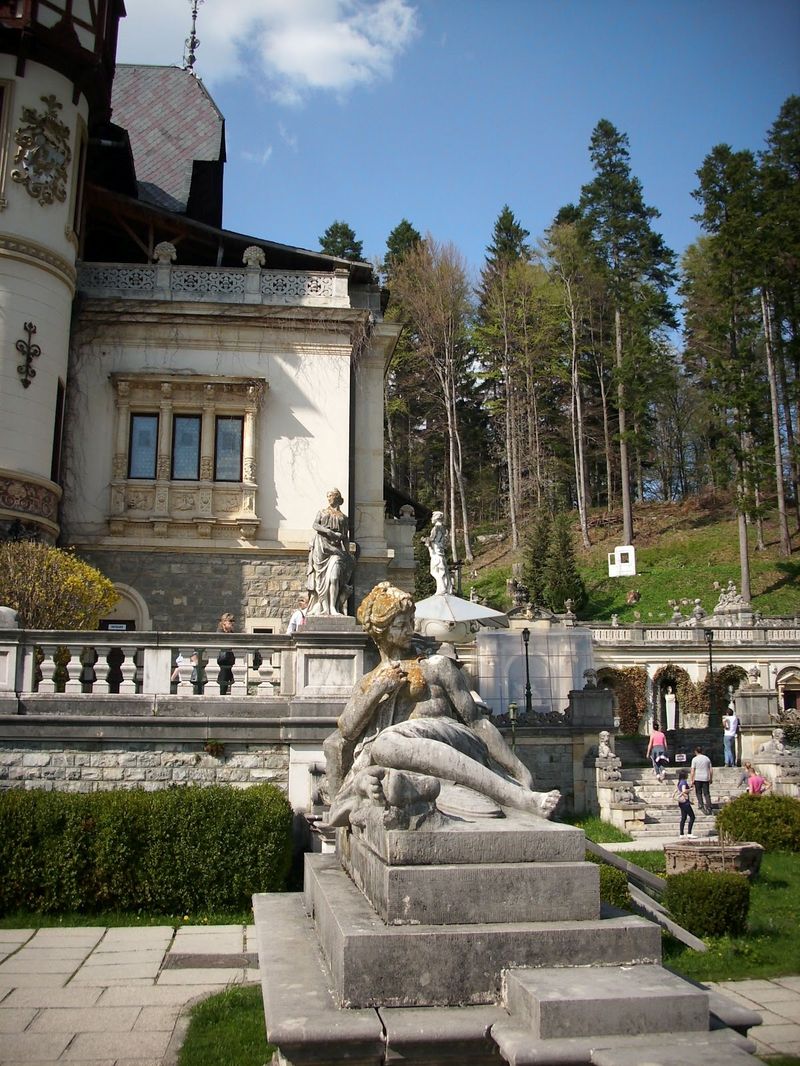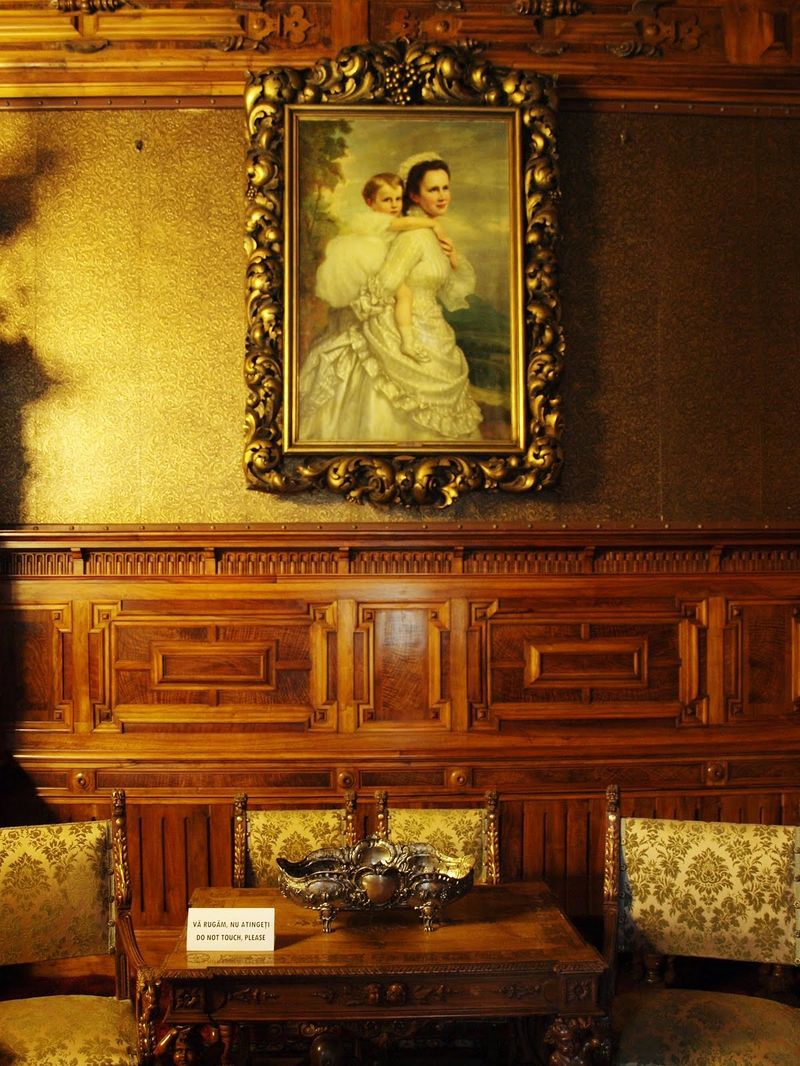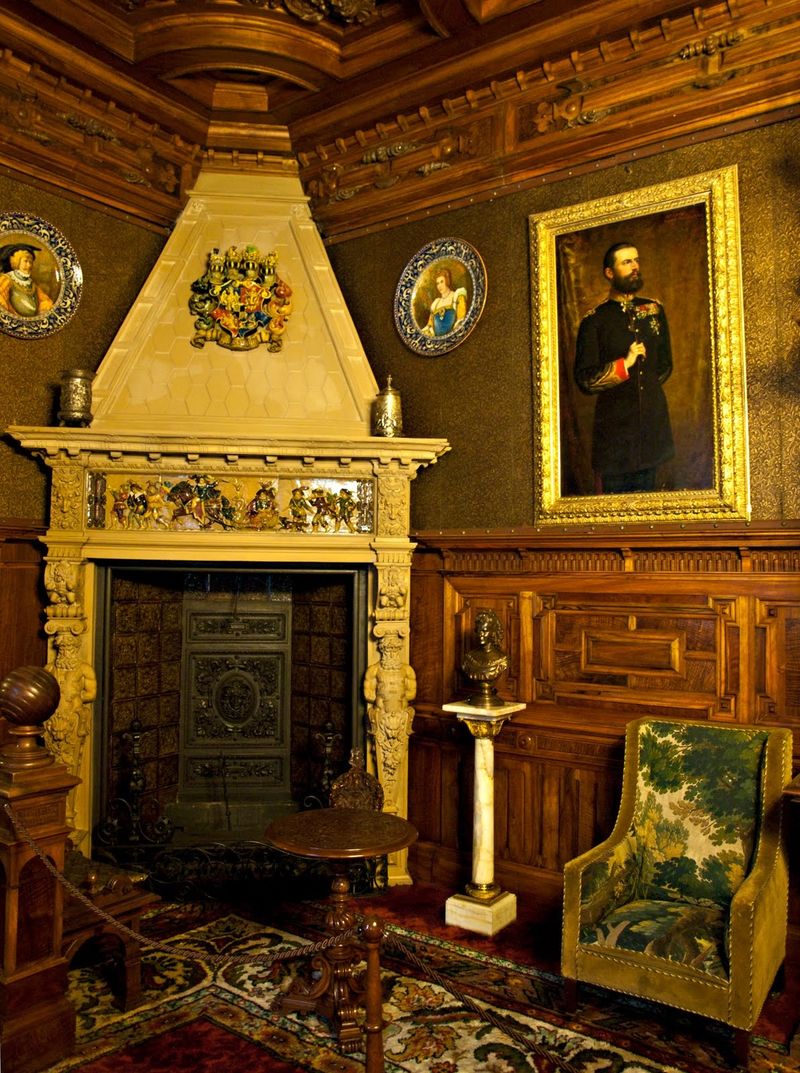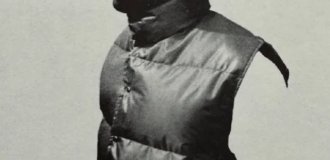Peles Castle (Castelul Peles) in Romania (55 photos + 2 videos)
We learned an amazing story from one blogger about the history of Peles Castle, which is located in Romania.

Once upon a time, the Bucegi massif in the southern Carpathians was known as a wild place. Not everyone dared to set out on the “princely road” - a mountain path winding among the rocks along the Prahova River. If you believe the legend, the history of this region was radically changed by one episode during the medieval boyar civil strife. ... Spentar (military leader) Mikhail Cantacuzino was leaving along the “princely road” from the pursuit sent by the leader of a rival principality ... The mad race exhausted the strength of his Arabian horse, and in the Peles valley he had to say goodbye to his faithful friend. Here, having quenched his thirst by a mountain stream, the warrior made a vow: if he managed to escape, he would build a monastery on this place. The enemies lost track of Mihai, and six years later, returning to his homeland after wandering in foreign lands, he kept his word. And since the monastery built on his order was a copy of Sinai, which struck the Spentar during his eastern wanderings, this place was called Sinai.

The inhabitants of the mountain monastery were, apparently, not only diligent servants of the Lord, but also zealous owners. The monastery quickly began to acquire land and took over the surrounding vineyards, pastures, salt and oil mines. In the nineteenth century, the “princely road” was replaced by a decent highway, along which quarries and manufactories grew. But today Sinaia is famous, first of all, as the best mountain resort in Romania. And the town owes this turn in its destiny to King Carol I and the Peles Castle he built here.

Carol (Charles) I, a descendant of one of the branches of the Prussian Hohenzollern dynasty, was elevated to the Romanian throne shortly after the merger of the principalities of Moldova and Wallachia into a single state.

Touring his new possessions, the founder of the Hohenzollern-Sigmaringen dynasty ended up in Sinai in 1867 and, enchanted by the beauty of these places, ordered to build a residence here. This is how Peles Castle was founded, and around it, as usual, palaces and villas of the monarch’s close associates, hotels and sanatoriums for wealthy lovers of mountain air began to grow.

The best architects, sculptors, and interior designers from different parts of Europe worked on the ensemble of buildings scattered throughout the royal park. The main one, which served as the residence of Carol himself, is now a museum where crowds of tourists are greeted by family portraits of the Hohenzollerns, ancient weapons on the walls, mannequins in knightly armor, and magnificent stained glass windows by German masters. There are also giant Venetian glass mirrors, cozy living rooms in Moorish and Turkish styles, and an orchestral music cabinet imported from America, a true work of art that can decorate any collection of antiques. And of course, as befits a real medieval castle, there are secret doors and passages. But this is more a tribute to tradition than a necessity in enlightened times when this little miracle was created.

If Sinaia in Romania is called the “pearl of the Carpathians,” then Peles Castle can be called the pearl of Sinaia itself. And at the same time, in the guidebooks of the 70s and 80s of the last century there is not a word about the castle! The secret is simple: the Hohenzollern family nest served as one of the many residences of the Ceausescu clan, so the gates of Peles Castle remained tightly closed to the public. Perhaps this is where today’s pilgrimage of tourists comes from, queuing to get into the royal chambers.

The century of the Hohenzollern-Sigmaringen dynasty was short-lived: it ruled Romania for only 81 years. Much is connected with the Peles Castle in its chronicles: the founder of the dynasty died here, Carol II, the father of the last Romanian monarch Michael I, was born here. But at present, the toy buildings and sculptural groups of Peles a la Versailles are no longer associated with the “gloomy German genius” . The only exception is, perhaps, the monument to King Carol I, looking sternly at his possessions from under the visor of a military cap. Still, the Prussians lived here...

The castle was built simultaneously with a power plant on the river that flows nearby, so Peles is also the first electrified castle in Romania. The castle was built by literally the whole world. Gypsies, Turks, Poles, and Czechs worked on it. A true international. During the War of Independence, construction slowed down, but after that it began to boil with renewed vigor. King Carol II was born in this castle. It was not for nothing that his father gave the castle the name Peles, which meant the cradle of the nation. When Carol the First was dying, he ordered his son to make a museum out of Peles. After the death of his father, Carol II, like an obedient son, fulfilled his dying will. The castle began to work as a museum, remaining a royal domain. The castle did not last long as a royal apartment. After the communists came to power, the castle was confiscated into public property and miraculously was not looted.

After some time, the castle becomes a museum. From 1975 to 1990 the castle was closed to visitors. As is known, the then leader of Com. Romanian Party Nocolas Ceausescu suffered from a whole range of phobias. So, to prevent the castle from being ruined by the zealous relatives of the then government, the museum workers came up with a legend that the castle had a fungus that spoils the wood and is very harmful to humans. Whether this is true or not, Ceausescu never showed up at the castle. In 1989, Romania becomes a capitalist country. In 2006, the castle was returned to the former king. Mihai took ownership, but soon reached a consensus with the authorities and the castle was sold to the state for 30 million euros. Now it delights all visitors with its beauty and charm. But filmmakers continue to treat this castle with special reverence. More than one famous film was shot here.



The main entrance hall is the highest room of Peles Castle - 3 floors, 12 meters high. The hall reproduces the famous German Chamber of Commerce in Lübeck. Italian Revival furniture. Initially it served as a courtyard. In 1911 it was covered with a mobile ceiling, which can still be moved today to ventilate the room. This hall was decorated with wood and you can see 2000 figures in it. On the panels there are two rows of alabaster bas-reliefs (marble plaster) - depicting mythological, biblical and historical scenes. The rich marquetry on the walls depicts 18 castles in Germany and Switzerland - the residence of the Hohenzolern dynasty.

The Hall of European Weapons is decorated in German Revival style. The hall contains European weapons from the 15th to 19th centuries. The palace has the second collection in the country - 3,500 weapons. Crossbows, halberds, cannons, shields, and spears stand out on the walls.
The Hall of Oriental Weapons of the Peles Palace presents various types of weapons painted with gold, silver, precious stones, and corals. The most valuable of them is the Turkish weapon - half pistol, half dagger.

The king's study at Peles Palace is decorated with paintings and furniture in the German style. Between the stained glass windows there is a music stand for official audiences, and next to it is the table where the king worked.
The king's library at Peles Palace contains about 800 volumes. The rest of the books (about 10,000) were in the permanent royal residence in Bucharest. The library has oak wood carvings. There is a secret door in the hall, which communicated through a spiral staircase with the king's bedroom on the third floor.

The meeting room is the last audience room. This was the last room added to the palace in 1914. It was decorated in the year the king died. Therefore, part of the hall remained undecorated.
The music room has a more austere decoration, made of spruce wood. Which also served as a hall for creative evenings. Carol 1 and Elizabeta were visited by great figures of Romanian culture such as George Enescu, Vasile Alexandri, Mihai Eminescu and other artists. The furniture set, a gift to the king from an Indian prince, is the main exhibit of the hall. Three generations of craftsmen worked on it for 104 years.

The Florentine Hall is the first of a series of reception halls. The decoration is in Italian neo-renaissance. The hall is richly decorated with marble and carved gilded wood. Original chandeliers made of Murano crystal. Venetian mirrors that reflect the ceiling. On the floor there are original oriental carpets made of natural silk.
Dining room - decoration made from various types of wood. Furniture in the German Baroque style. The original stained glass windows (18th century), made in Munich, depict scenes from the life of the German nobility. The ceiling and chairs are covered with Cordoba leather.

The Moorish Hall is the third reception hall of the Peles Palace, in the Arabic style with ivory and mother-of-pearl inlays. The ceiling is made of linden and plaster. There are oriental weapons on the walls (XV - XVIII centuries). On the carpet and on the stools are verses from the Koran.
The Eastern Turkish Hall of Peles is an original decoration made of silk embroidery, specific to the Turkish style. On the tables there is a hookah and a vessel for burning incense. On the floor is an oriental carpet from Smyrna.
The auditorium is a theater hall in the Peles Palace with 60 seats, in a French Louis XIV style setting. In 1906 the hall became a cinema hall.

Peles Castle was built in the neo-Renaissance style, but the half-timbered courtyard facades with their luxuriously painted walls show Saxon influence, and the Baroque influence is noticeable in the interiors, decorated with rich wood carvings and fine fabrics. Its external decoration looks like a castle from a sweet fairy tale. It is somewhat similar to a fairytale castle made of ice cream and cookies. But at the same time, it differs from all the pretentious and pompous castles of Western Europe. Its style can be described as a light Swiss chalet. It is incredibly chic, the architecture here is simply dazzling, but in some ways there is still restraint, unlike all other castles. Most likely, this is due to a mixture of styles.
A huge number of sculptures, a gorgeous park around, incredible frescoes on the walls, the wood carvings that decorate the façade of the house, the interior, walls, and furniture are legendary. You can talk about this castle for hours. It was perfectly integrated by its former architect, Johann Schulz, into the surrounding landscape. A snow-white building with dark wood trim, a pointed turret, many patterns on the windows, on the roofs, on the balustrades. And there are frescoes everywhere. The picture is complemented by beautiful lanterns in the park and many sculptures.

Peles Castle has a huge number of exhibitions that are constantly changing, and not all of its rooms are open to the public. The collection of weapons, including 4,000 items (15-19 centuries, from the East to Europe), is considered especially valuable. Another pearl of this castle is the collection of Maximilian equipment for horses and knights, it is the only one of its kind in Romania. And there are not many of these in Europe.

The area of Peles Castle is 3200 sq. meters, which housed more than 160 rooms, 30 bathrooms, luxuriously furnished and exquisitely decorated. Among the many exquisite rooms, distinguished by style and design, are the Florentine room, the French room, the theater and study rooms. The tableware collection includes Meissen and Sevres porcelain.
It has one of the finest collections of art from eastern and central Europe, which includes sculpture, paintings, furniture, weapons and armour, gold and silver work, ivory, porcelain, carpets and tapestries. The collection of weapons and armor includes more than 4,000 items. Oriental carpets were produced in the best workshops in Bukhara, Mosul, Isparta and Smyrna.

In this unique castle there is only one fake, masterfully executed, a fake fireplace. By the way, an elevator was installed for the first time in Europe at Peles Castle. The ceiling paintings decorate the entire castle are also unique. They not only repeat, but are absolutely identical to the patterns on the carpets. Without any exaggeration, we can say that this is the most unique castle in Europe with the richest collection.
Since everything in Peles Castle smacks of originality, the architects could not ignore even the ceilings. Instead of standard ceilings, the castle has ceiling stained glass windows, and they are all sliding. Stained glass windows fit harmoniously into the architectural ensemble of the house. By the way, they were hand-painted by Swedish craftsmen. These stained glass windows still provide natural ventilation to the castle.

Since its opening, Peles Castle has received almost half a million visitors every year. But, unfortunately, there are almost no Russians among them. For this reason, unfortunately, excursions in Russian are not offered here either. At the main entrance stands a statue of King Carol I, the work of the Italian sculptor Raffaello Romanelli, who also owns the statues made of Carrara marble, located on seven beautiful Italian terraces surrounding the castle and made in the neo-Renaissance style. The park also contains a monument to Queen Elizabeth, depicting the wife of King Carol I doing embroidery, a traditional Romanian art. The gardens and terraces are decorated with fountains, urns, staircases, lions, beautiful statues and other decorative details.

The highest room in Peles Castle is the main entrance hall. Its height is 12 meters, which is equal to the height of three floors of the castle. The main entrance hall is the highest room of Peles Castle - 3 floors, 12 meters high. The front lobby reproduces the famous German Chamber of Commerce in Lübeck. The furniture here is in Italian Revival style. Initially, the front vestibule served as a courtyard, but at the request of the owners, in 1911 it was covered with a mobile roof, which even today can be moved apart to ventilate the room. On the panels of the front vestibule are two rows of alabaster bas-reliefs (marble plaster), which depict mythological, biblical and historical scenes. The rich marquetry on the walls depicts 18 castles in Germany and Switzerland - the residence of the Hohenzolern dynasty.

You should definitely pay attention to the hall of European weapons. It is decorated in German Revival style. Unique and rare examples of European weapons from the 15th to 19th centuries are collected here. Also in Peles Castle there is a hall of oriental weapons. Here are various types of weapons decorated with gold, silver, precious stones, and corals. The most valuable of them is a Turkish weapon - half pistol, half dagger. The study of King Carol I in Peles Castle is decorated with paintings and furniture in the German style. Between the stained glass windows there is a music stand for official audiences, and next to it is the table where the king worked. The room in which the library is located is decorated with oak wood panels with carvings. A secret door from the library leads through a spiral staircase to the king's bedroom on the third floor. The library at Peles Castle contains about 800 volumes. The rest of the books, about 10,000 of them, were kept in the permanent royal residence in Bucharest.

Another room in the castle that I would like to pay special attention to is the music room. The decor of the music room is more austere, made of spruce wood. The unusually exquisite furniture set of the music room attracts attention. It was given to King Carol the First by an Indian prince. Three generations of craftsmen made this set for 104 years. Creative evenings have been held in this hall several times. Here, great creative personalities of Romanian culture - George Enescu, Vasile Alexandri, Mihai Eminescu and other artists - visited Carol I and Elisabeth.

The Florentine Hall is the main hall of Peles Castle, where lavish receptions were held. The design of this hall is made in the Italian neo-Renaissance style. The rich decor of the Florentine hall is made of marble and carved gilded wood. Murano glass chandeliers. The floor is covered with magnificent oriental carpets made of natural silk. The design and decor of the dining room is made using a huge number of different wood species, including exotic wood. Furniture in the German Baroque style. The original stained glass windows, made by Munich craftsmen, depict scenes from the life of the German nobility. The ceiling and chairs are covered in Cordoba leather. The Moorish Hall is the third reception hall of Peles Castle. Made in the Arabic style with numerous ivory and mother-of-pearl inlays. On the walls are oriental weapons from the 15th to 18th centuries.

In the eastern Turkish hall of Peles there is an original decoration of silk embroidery inherent in the Turkish style. On the tables there is a hookah and a vessel for burning incense. On the floor is an oriental carpet from Smyrna.

The castle also has a theater auditorium with 60 seats. It is made in the French Baroque style of Louis XIV. In 1906 it was converted into a cinema hall.
















































